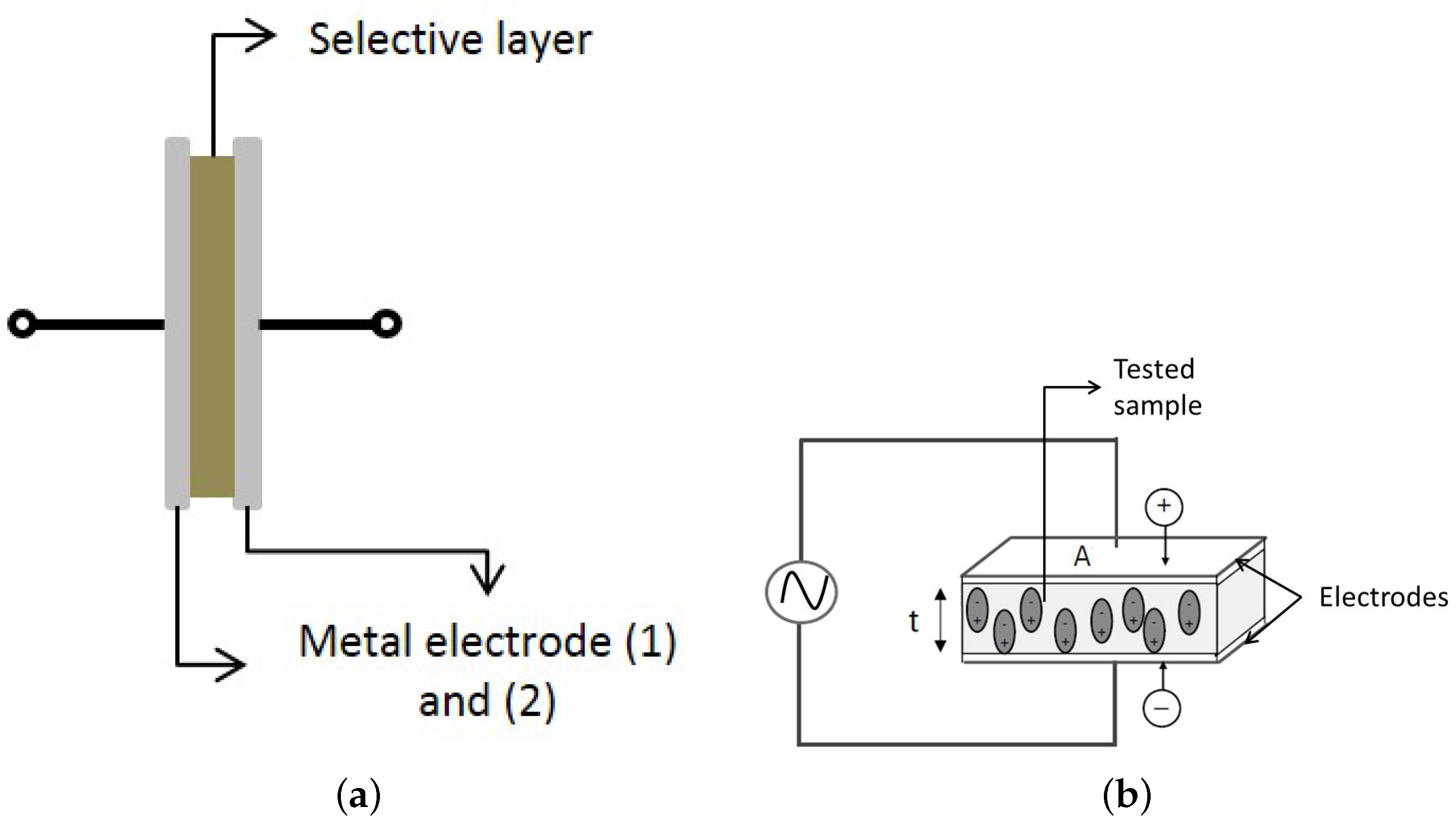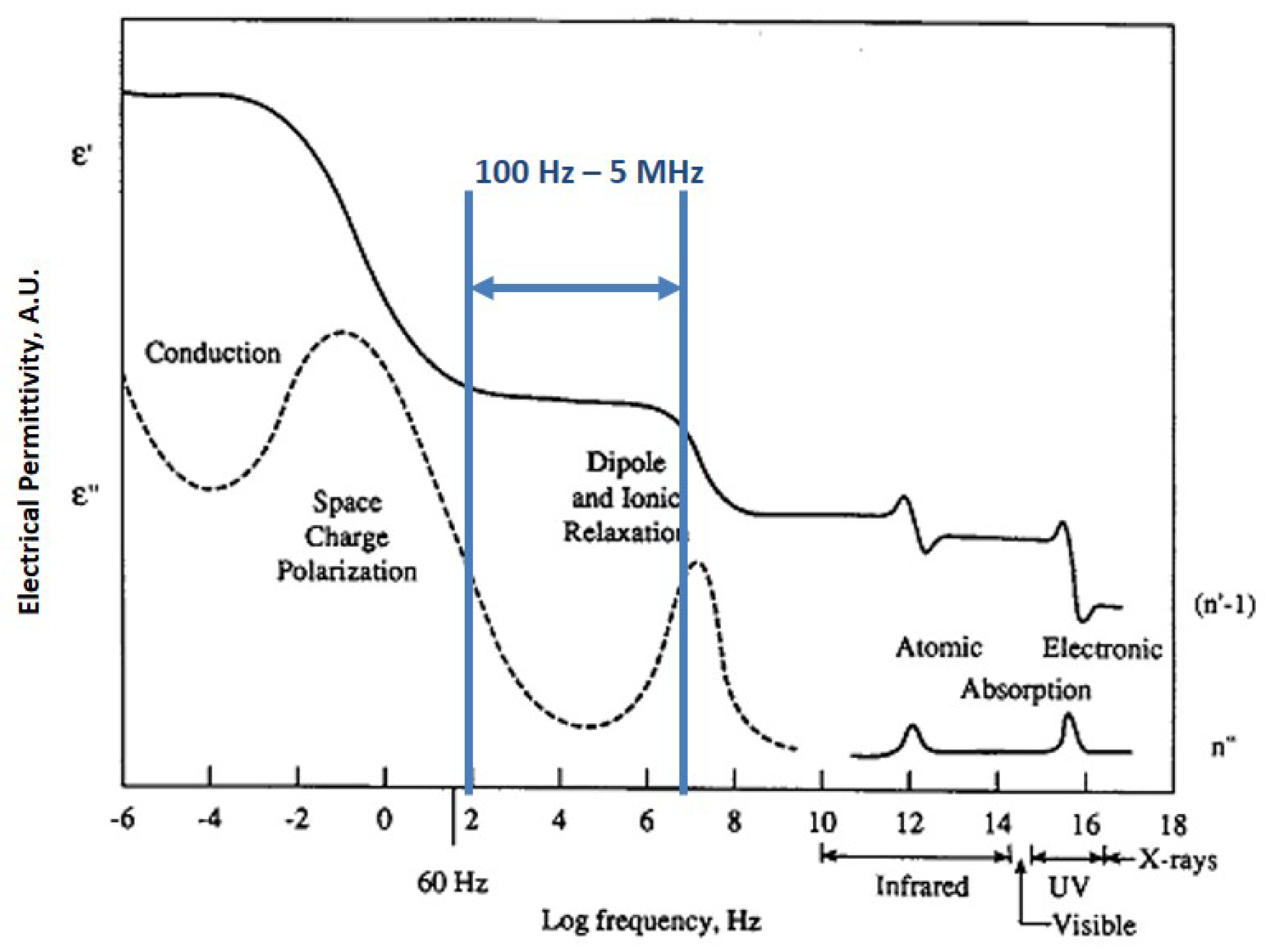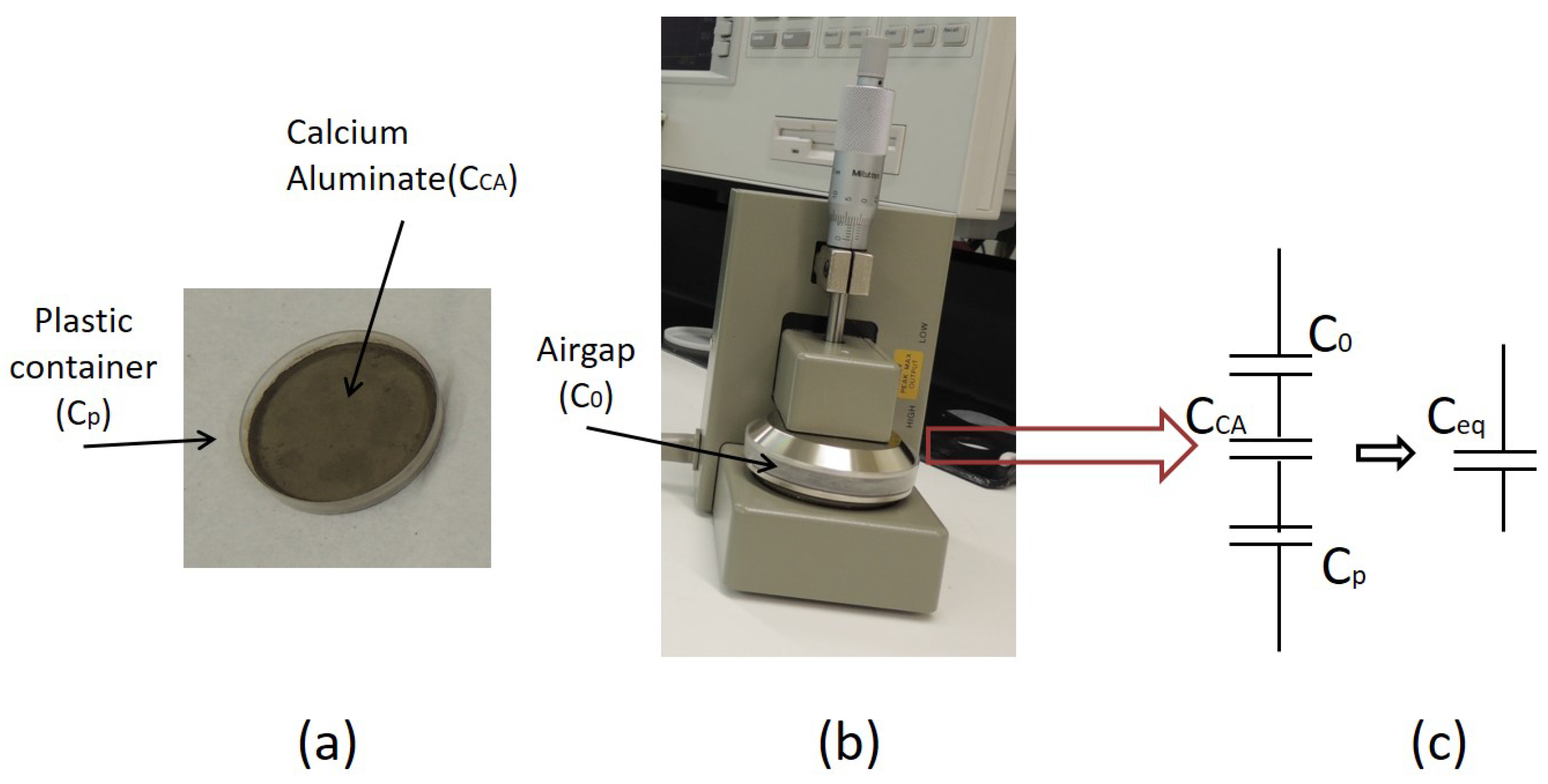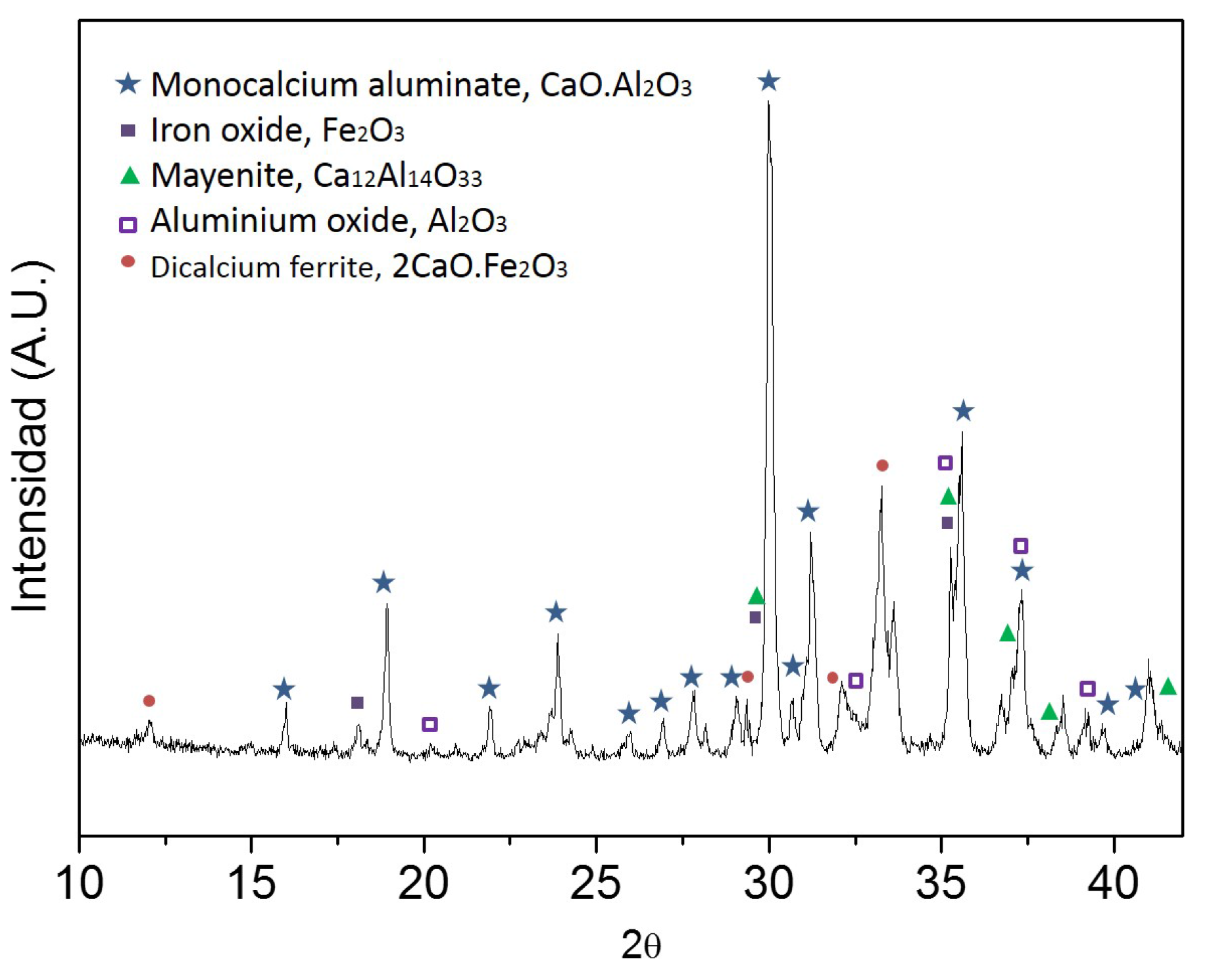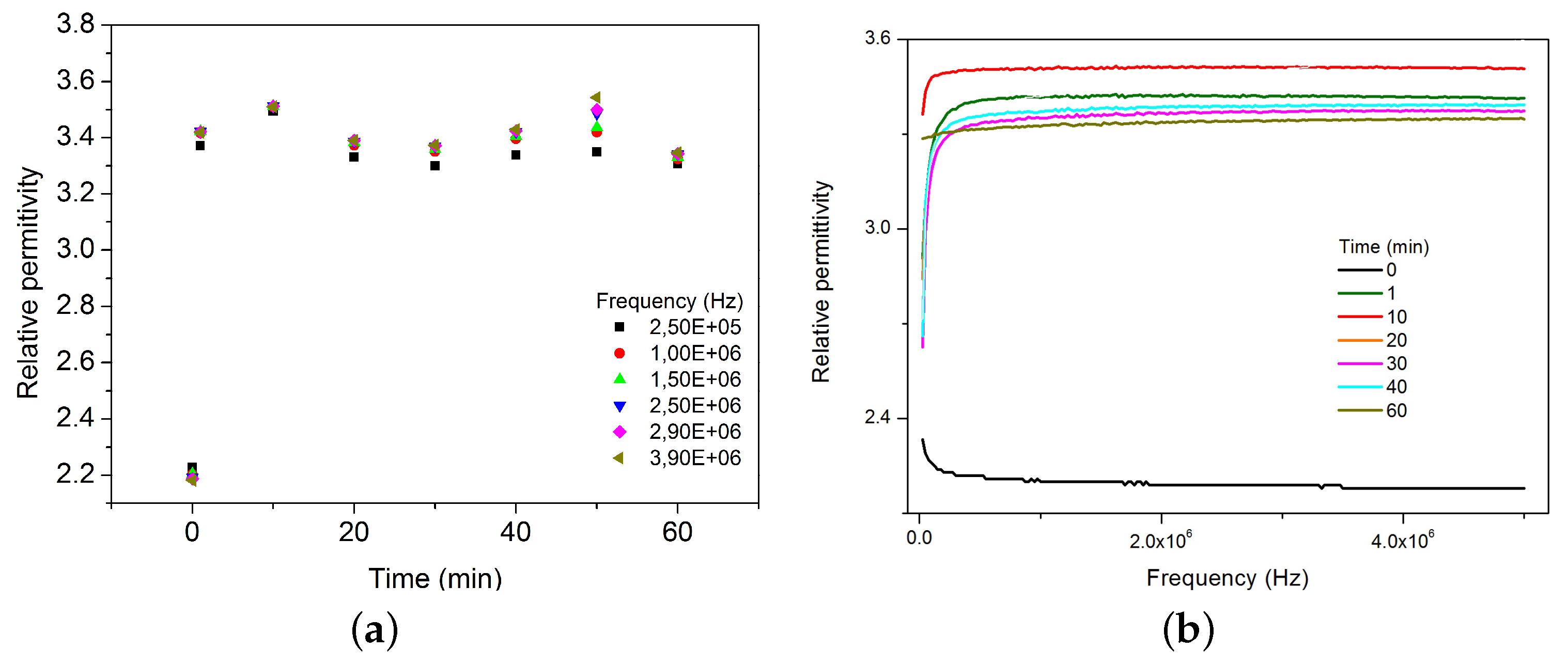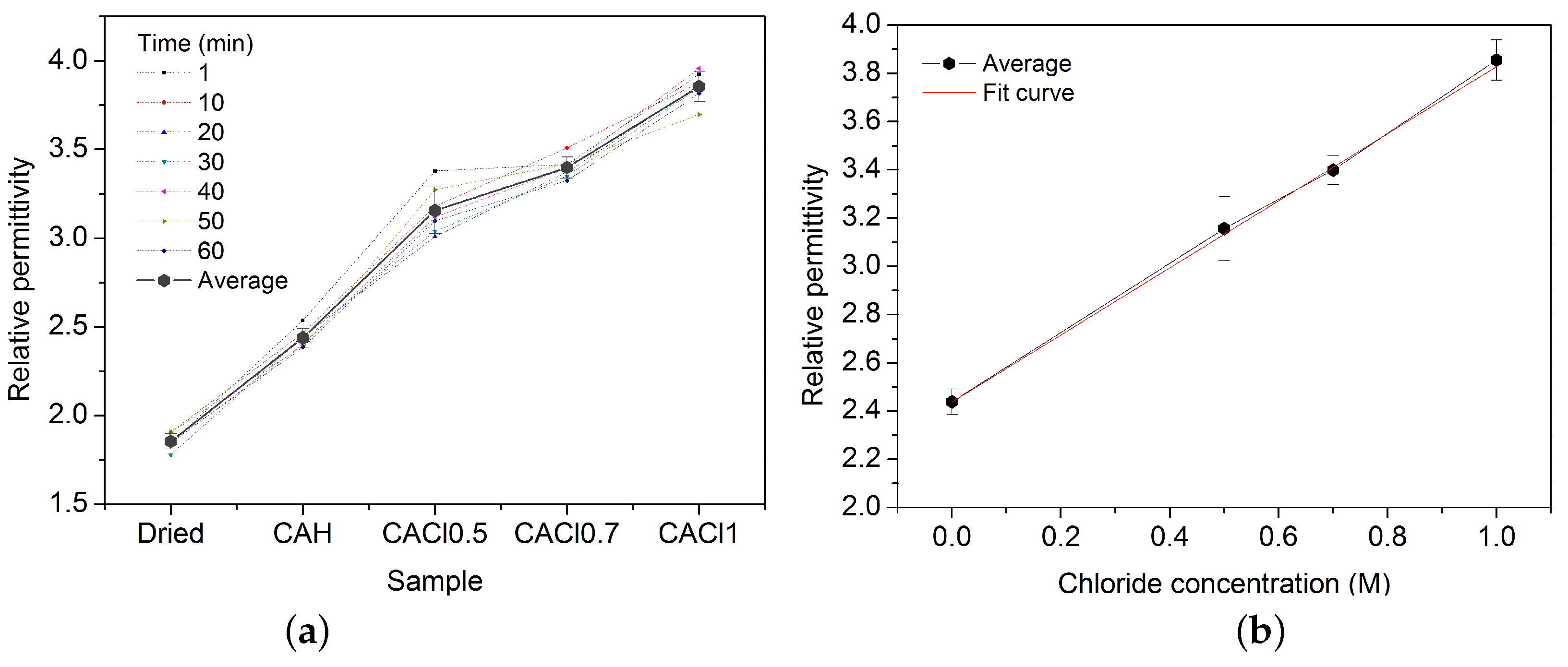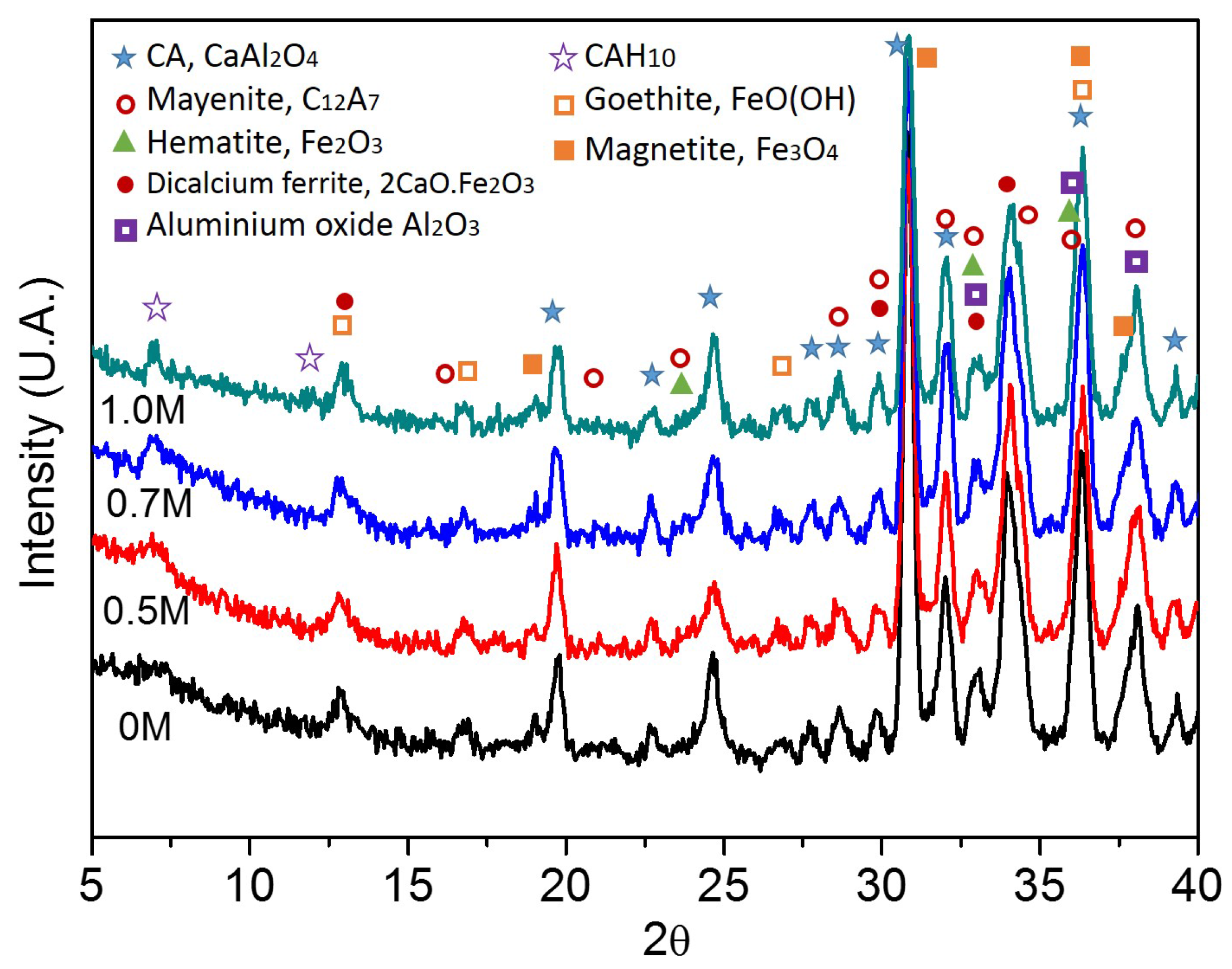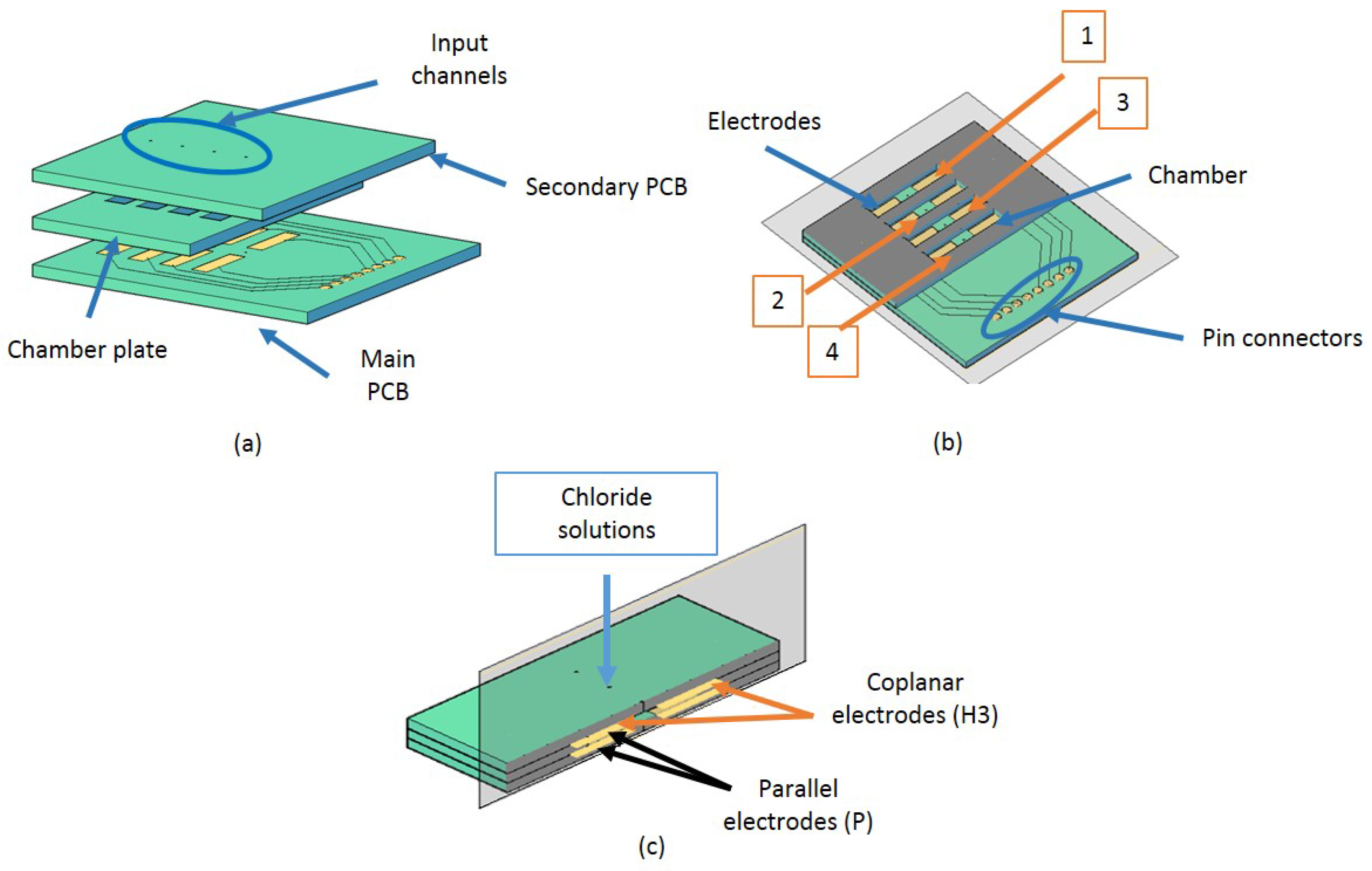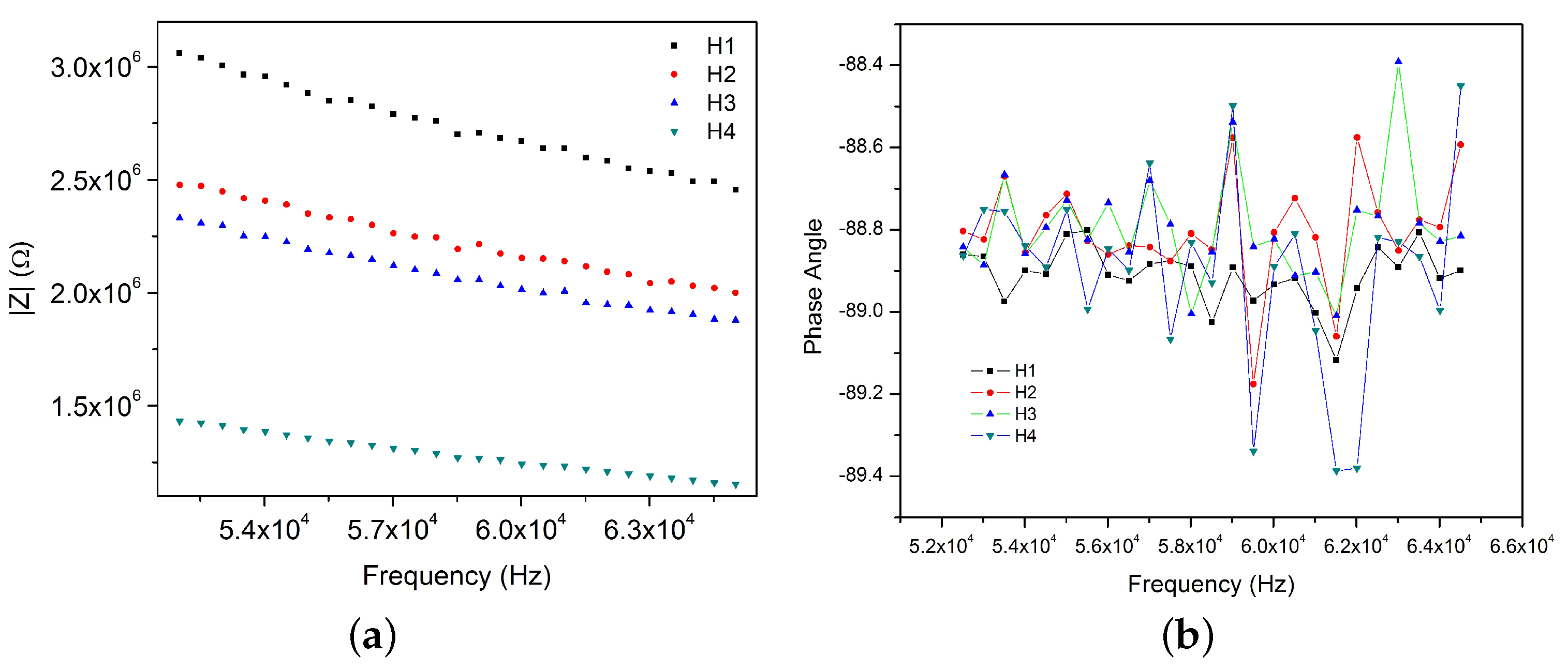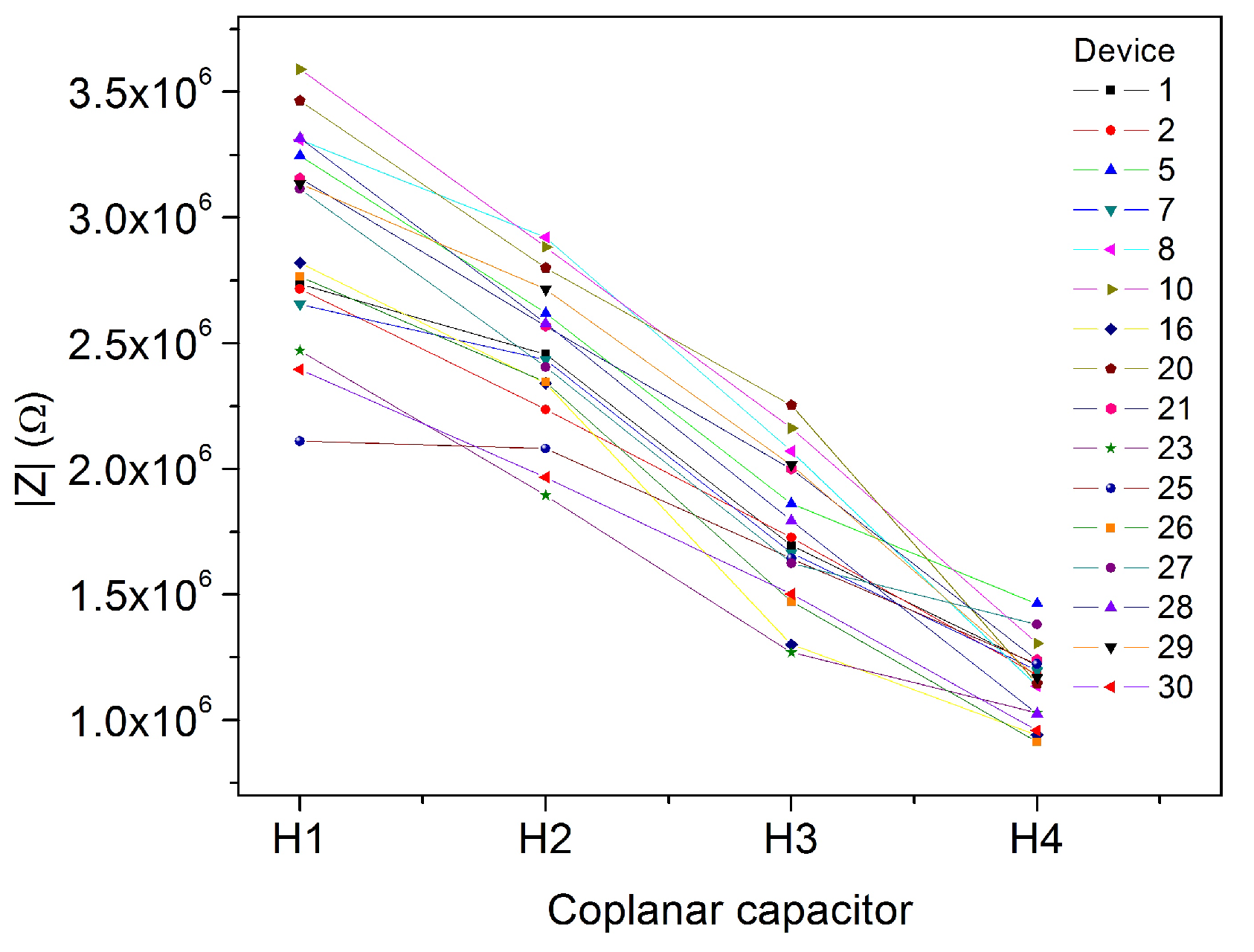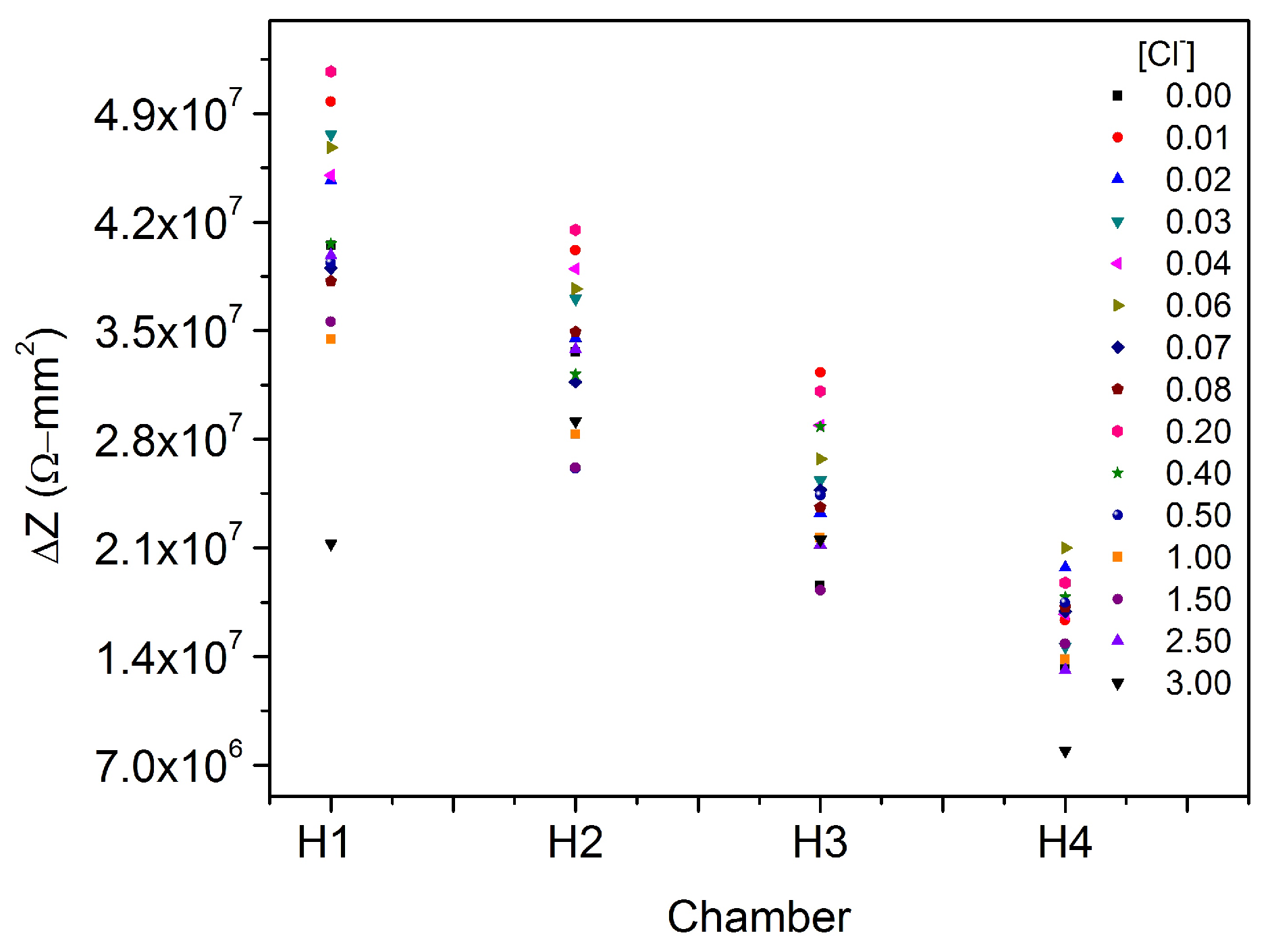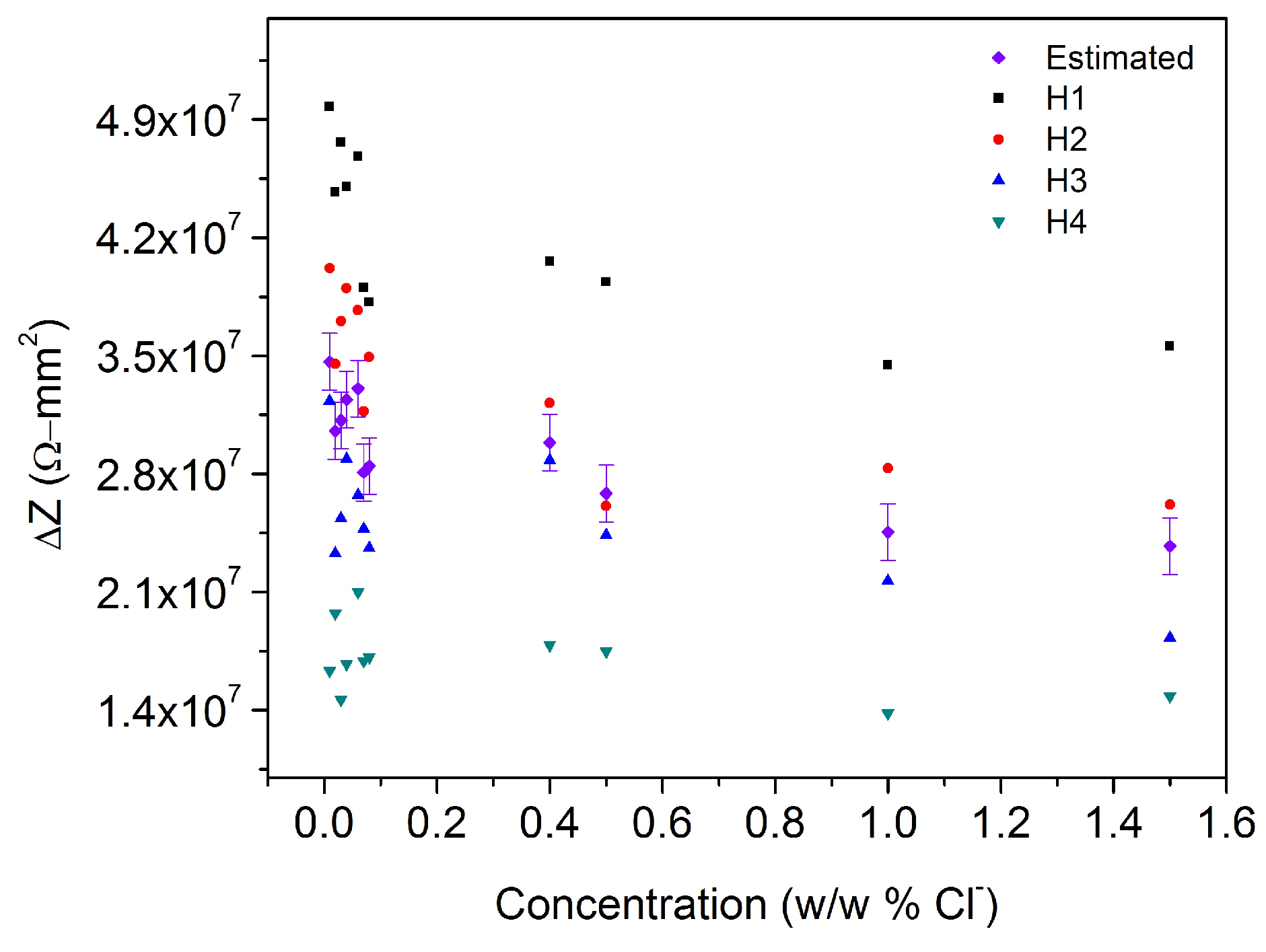The proposed device is a conductimetric sensor that consists of two electrodes and a selective layer that interacts/reacts with chloride ions. The device has eight pairs of electrodes (
Figure 9). This configuration allows chloride ingress assessment in any structure at different depths, or multiple measurements on the same depth depending on the device position. Additionally, it is possible to measure impedance changes between coplanar electrodes allowing early detection of chloride presence.
The selective layer is monocalcium aluminate (CA) that showed a dependent electrical behavior on chloride presence. It means that electrical properties of CA are proportional to chloride concentration.
4.2. Performance Tests
The variables that were considered in this phase are summarized in
Table 4. The proposed experimental design had two factors: concentration and time, the first one with 20 levels while the second one had 13, and one block with four levels (chambers). According to experimental design theory, this kind of experimental design is called Randomized Blocking Design (RBD), and the statistical model related to this design is:
where
is the response
Z;
is a parameter common to all treatments called the overall mean;
and
represent the effects of the factors (i.e., concentration and time) and their interactions;
is the block effect (chamber); and
is the model error with NID (0,
) (standard normal distribution: average of zero and a constant variance).
,
, and
are parameters unique to the
ith,
jth or
kth factors/block and their combinations, and they represent the deviations from the constant when a specific treatment is applied [
40].
Using the designed device (
Figure 9), now the probe for measuring was the Kelvin Clip 16089A, and the impedance analyzer is still the Agilent 4294A, used in the previous phase. This instrument works in the frequency range of 100 Hz to 100 kHz, at a voltage of 0.5 V, and at 19 ± 1 °C. For this phase the frequency range studied was between 52 kHz and 65 kHz. This reduction on the frequency was possible due to the steady state that commercial CA showed in the previous phase (
Figure 6). In addition, this probe did not measure capacitance but impedance, that in this stage is the response under studying.
Regarding the porous and toruous microstructure of the powder, a heterogeneous diffusion inside the chambers can take place. It means, that it is possible that chlorides go inside the chambers with some directionality making parallel capacitors measurements different from those coplanar measurements. Because of this, just the coplanar results are shown in this paper.
Figure 9 displays the labelling of each chamber and one example of their names. The others are: H1, H2, and H4 depending on the chamber where the measurement were taken.
By using this experimental design, it is possible to determine sensitivity and response time without forgetting the possible effects of the chamber.
Table 5 shows concentrations and times regarded in this study. The selected concentrations correspond to the working range under real conditions, and focusing on small concentrations allows to determine the resolution of the proposed device. All the combinations between them (
Citj) were performed 4 times (one time per block). In total, 21 devices were used. Additionally, at the beginning of each experiment the impedance of the dried CA (DCA) is measured as a reference (
).
The results and their analysis are divided into three parts: the first part is focused on the design suitability of the device, the second part explores the overall performance of the device when the CA inside it interacts with chloride solutions, and the third part uses the statistical analysis for determining the sensor’s performance and sensitivity.
4.3. Design Suitability
Two different measurements are studied: those made with the device empty (NCA), and those made with the dried CA (DCA) inside the device (dried measurements were done before CA interacts with solutions for all devices). In order to do this, one device (NCA) is analysed, and results from two of the devices are shown as examples of dried CA behavior (D12 and D20); however, statistical analysis is done over all 20 devices (the 21th device was empty).
4.3.1. Empty Device
From coplanar capacitors measurements shown in
Figure 10b, to conclude that parallel capacitors are quasi perfect capacitors is possible since in the phase angle diagram the values are near to −90° (approximately 88.8%). It means, that in this frequency range (52 kHz–65 kHz) there is not any electrical resistivity behavior and capacitance values are virtually independent of frequency variation.
In addition,
Figure 10a shows a tendency between the measurements. Even when none of them register exactly the same value, their magnitude orders over the frequency do not change (∼10
6 Ω).
Besides, impedance measurements increase when the chamber is far from the pin connectors; and impedance of chambers two and three (H2 and H3) are closer between them than to the others. This fact can be caused by geometrical or electric factors.
4.3.2. Dried CA
On the other hand, when devices are filled with CA the impedance increases since the CA is a dielectric material; however, the order of magnitude is the same as that when the device was empty (
Figure 11). Besides, capacitors still behave as quasi perfect capacitors (
Figure 11b). From both figures it is possible to conclude that measurements are coherent between device 12 and device 20. The measurement behavior is the same than for the empty device: impedance decreases from H1 to H4.
Regarding the variation of impedance between coplanar electrodes from different chambers,
Table 6 shows the mean, standard deviation and coefficient of variation (
COV =
Std.Dev/
Mean) for all 20 measurements made at one frequency (
f = 60,016 Hz).
Figure 12 displays the data for dried CA.
From
Table 6 and
Figure 12 it is possible to observe that for the same conditions, impedances of H4 are the lowest, this could be due to the electric path that is the shortest one; thus, the impedance due to the path is less than for H1, H2 and H3.
Likewise, the variation between measurements (standard deviation) from the same chamber decreases from H1 to H4. This could be explained since H4 is the closest chamber to the electric pins, it means that the electric path is the smallest one.
Similarly, the COV over the frequency is almost the same for each chamber, and also, the variation is not very different between chambers, since their values are between 12% and 16%.
4.5. Performance Tests and Sensitivity
Figure 14 displays the behavior of all coplanar capacitors in presence of 15 different chloride solutions at 60,016 Hz according to the chamber where the measurements were taken (H1, H2, H3 or H4). Note that we have considered just 15 from the original 20 concentrations due to some experimental problems.
The first interesting result is that all the measurements shift according to the chamber from higher to lower impedance differences. This fact is a proof of the effectiveness of the RBD. Likewise, all of the measurements have the same magnitude order (∼107 Ω·mm2).
Using the software PASW Statistic 18 (SPSS) the statistical tests of the data shown in
Figure 14 were performed for a confidence interval of 95%.
Table 7 summarizes the complete analysis of variance of this experiment. This table states that the overall mean
cannot be neglected(
). Besides, concentration significantly affects the impedance changes (
). In addition, it shows that the chamber affects the measurement of the impedance once the solution interacts with the CA (
). In addition, R squared of 0.928 is in reasonable agreement with the adjusted R squared of 0.899. Their difference is less than 0.20 (0.029) that indicates that there is no problem with the model or/and data.
Likewise, by using the Fisher LSD test for probing
:
:
where
is the t-student value for the number of experiments (
), and for the number of treatments (
) with a significance coefficient of
,
the mean square error (
Table 7), and n the number of blocks (
). It is possible to compare the means of the treatments to determine the difference between them and recognizing some parameters of the sensor under lab conditions such as limit of detection and resolution.
According to
Table 8 it is possible to say that there is a significant difference (
) in the system response when 0.01 wt % (
ith) is added compared when the CA interacts with deionized water (
jth). Similarly, observing the significance for mean comparison, there is not any difference between 0.01 wt % and 0.02 wt %, 0.03 wt %, 0.04 wt %, and 0.06 wt % (
). The
p-value is significant just when the solution is 0.07 wt %, then the difference between the limit of detection (0.01 wt %) and the next concentration that affect the response (0.07 wt %) is 0.06 wt % . This is the resolution of the device.
These results show that the device present a limit of detection of 0.01 wt % Cl
−, and the resolution, it means, the lowest concentration difference is 0.06 wt % Cl
−. In addition, they show that the capacity of detection is lower than that observed (0.026 wt % Cl
−) in the previous phase when CA were characterized,
Section 3.
Finally, with the same software it was possible to estimate the parameters for the effects model (Equation (
8)) proposed in
Section 4.4.
Table 9 lists all of the values at 60,016 Hz. According to this table, it is important to highlight that statistically, chamber 4 and 3.00 wt % solution are redundant. It means that their values can be partially or completely deduced from the values of other data items. In addition, the
p-value for 1.50 wt % Cl
− solution is not significant. In addition, taking into account that in the previous
Table 8 value 2.00 wt % Cl
− shows also a different behavior, it could mean that the upper limit of measuring using the Chlordetect is near to 1.50 wt % Cl
−. However, for proving this hypothesis it is necessary to perform more experiments under real conditions.
At the end, it is possible to observe the effect of chloride concentration on impedance difference, disregarding the chambers effects. In other words, the software makes a calculation for estimating the value of the impedance considering just the concentration.
Figure 15 displays the behavior for all the chambers at 60,016 Hz with their estimated value and standard error in presence of chloride solutions from 0.00 wt % Cl
− to 1.50 wt % Cl
−. From there it is possible to conclude that impedance difference decreases as chloride concentration increases.
